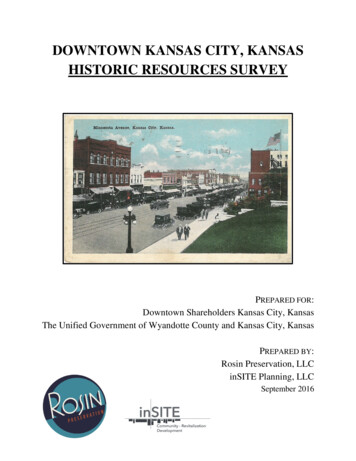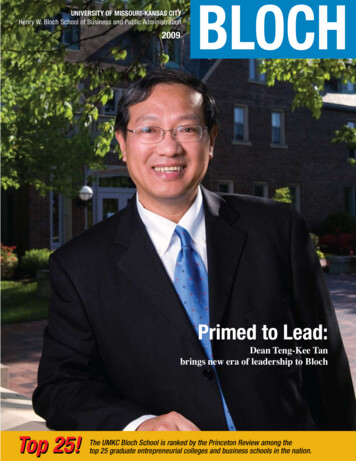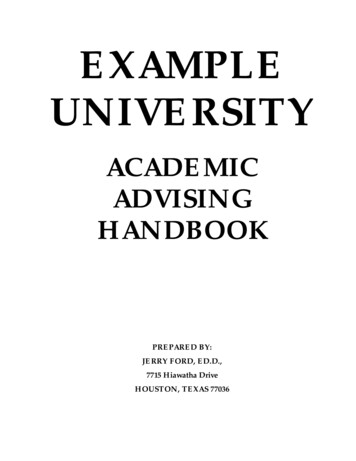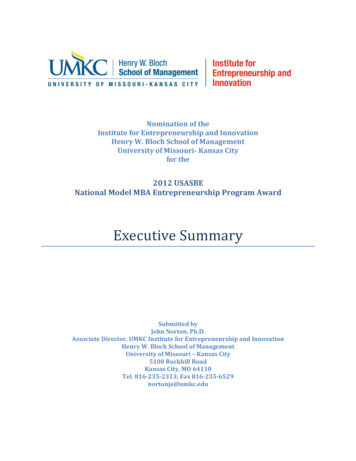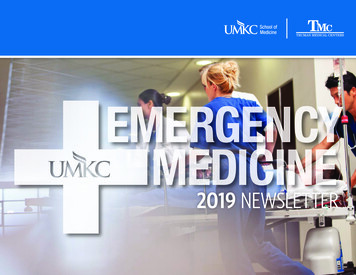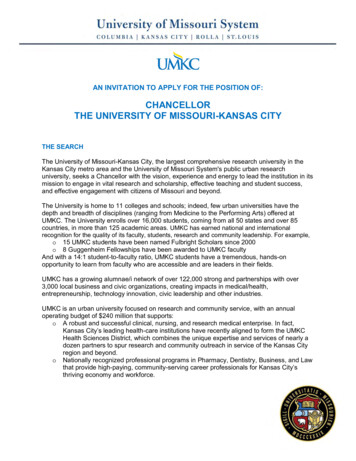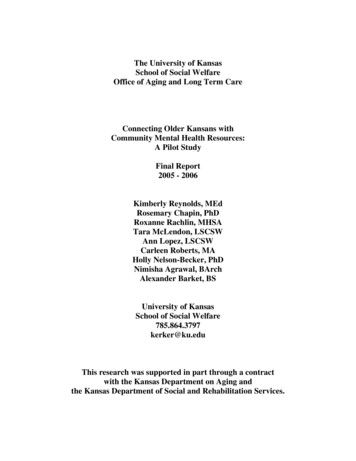
Transcription
The University of KansasSchool of Social WelfareOffice of Aging and Long Term CareConnecting Older Kansans withCommunity Mental Health Resources:A Pilot StudyFinal Report2005 - 2006Kimberly Reynolds, MEdRosemary Chapin, PhDRoxanne Rachlin, MHSATara McLendon, LSCSWAnn Lopez, LSCSWCarleen Roberts, MAHolly Nelson-Becker, PhDNimisha Agrawal, BArchAlexander Barket, BSUniversity of KansasSchool of Social Welfare785.864.3797kerker@ku.eduThis research was supported in part through a contractwith the Kansas Department on Aging andthe Kansas Department of Social and Rehabilitation Services.
TABLE OF CONTENTSExecutive SummaryA. PurposeB. BackgroundC. Project ActivitiesD. Key FindingsI. Year Three ActivitiesA. Statewide Training ImplementationB. Training EvaluationsC. Training ProductsD. CMHC SurveysE. 2003 AIMS Data AnalysisII. Project SummaryA. ConclusionB. Next StepsIII. AppendixA. List of Advisory Council MembersB. K6 Mental Health Screening ToolC. Training AgendaD. Main Themes & Number of Pre/Post Training Case Study Evaluation AnswersE. Case Study Evaluation Responses by Job TitleF. Training Manual and PowerPoints2Pg 3Pg 3Pg 4Pgs 4-6Pgs 6-11Pgs 11-25Pgs 25-26Pgs 26-37Pgs 37-46Pgs 47-49Pg 49Pg 52Pg 54Pg 56Pgs 58-67Pgs 69-88Pgs 90-167
The University of Kansas School of Social WelfareOffice of Aging and Long Term CareConnecting Older Kansans with Community Mental Health Resources: A Pilot StudyFinal ReportExecutive SummaryA. PurposeThe Kansas Department on Aging (KDOA) and the Department of Social & RehabilitationServices (SRS) contracted with the University of Kansas School of Social Welfare’s Office ofAging & Long Term Care (OALTC) to conduct “Connecting Older Kansans with CommunityMental Health Resources: A Pilot Study”. The purpose of this three year project was to develop,provide, and evaluate training and to identify and provide a screening tool to aging serviceproviders in order to enhance their ability to identify older adults who may be experiencingmental health problems and refer them to appropriate resources. This is the final report regardingthe three year study. It also summarizes the work completed during the final year of the study.B. BackgroundIn 2001, we completed a study of factors that appeared related to residents' tenure in assistedliving facilities and residential health care facilities (Resident and Facility Factors Related toResidents' Length of Stay in Assisted Living and Residential Health Care Facilities: ALongitudinal Analysis). During that study, we found that nearly one-third of residentsexperienced some type of mental illness (not including dementia), and that most were notreceiving mental health services.In 2002, in order to learn more about this phenomenon, we completed two additional studies.Through our study, Meeting the Mental Health Needs of Elders in Assisted Living & ResidentialHealth Care Facilities: Individual, Community & Facility Factors, we learned that residents witha mental illness were nearly twice as likely to discharge to a higher level of care than thosewithout a mental illness. Facilities also reported that their lack of knowledge about mental healthresources available to assist their customers was a key barrier to the customer receiving services.Through our study, Barriers to Accessing Mental Health Services for Residents in AssistedLiving and Residential Health Care Facilities: Resident and Community Mental Health CenterStaff Perspectives, we identified risk and protective factors that were related to older adults'mental health, and further documented the lack of awareness of mental health resources on thepart of older adults and their caregivers.This information was shared with key public and private stakeholders, who requested additionalresearch to identify a mental health screening tool and to develop training for front line staffincluding those from: assisted living facilities, Area Agencies on Aging (AAA), senior centers,and home health agencies. An Advisory Council comprised of stakeholders representing: stateagencies, aging providers, mental health providers, consumers, etc. (see Appendix A) helpedguide this three year study, Connecting Older Kansans with Community Mental HealthResources.
C. Project ActivitiesBased upon a literature review and findings from conducting four focus groups with older adults,we developed a one-day training for aging service providers about older adult mental health andmental health resources available. We piloted this training in two Area Agency on Aging (AAA)service areas, then utilized evaluation data to enhance the training materials. We thenimplemented this training statewide. We assembled the training materials and accompanyingPowerPoint presentations into a manual and onto a CD, and then distributed copies to variousaging service providers. We also added the information onto our website (www.oaltc.ku.edu).We identified a brief, validated mental health screening tool that aging service providers coulduse in determining which older adults might be experiencing a mental health problem for whichthey might benefit from referral to a mental health resource (see Appendix B). We thenincorporated information about the use of this tool (the K6) into the one-day training. We pilotedthe use of the tool, and, based upon feedback from participants, presented it as part of ourstatewide implementation of the training. We then created a “K6 Pocket Guide” and distributed1,500 to aging service providers.Since stakeholders also requested information about older adults currently receiving communitymental health center (CMHC) services, we also analyzed two years of a statewide CMHC dataset(the Automated Information Management System, or, AIMS) in order to develop a profile ofconsumers aged 60 utilizing their services.Statewide implementation of the training resulted in the widespread use of the mental healthscreening tool. Involvement of state representatives led to their incorporating the K6 into astatewide tool used to assess for community-based resources. And, ongoing analysis of theAIMS data has led to increased awareness by both aging and mental health stakeholdersregarding the potential opportunity CMHCs possess in addressing older adults’ mental healthneeds.D. Key FindingsAging Service Provider Knowledge About Older Adult Mental HealthAlthough at the outset of the training, some aging service providers appeared to possess a goodworking knowledge about the mental health problems of older adults, many reported lackingknowledge about how to assist customers in accessing specific mental health services. Also,most did not report any established relationship between their organization and a communitybased mental health provider.Aging Service Provider Use of a Mental Health Screening InstrumentWhile some aging service providers participating in the trainings were already using instrumentssuch as the Geriatric Depression Scale (GDS), most were not. After learning about the K6, manybegan utilizing the instrument, and most reported that it was easy to use, and that it may assist4
them in communicating with their customers and other service providers about customers’mental health.Importance of Informal SupportsDuring the older adult focus groups, participants emphasized their preference for aging serviceproviders to assist them in accessing informal supports, as opposed to formal mental healthservices. Aging service providers also reported that, frequently, informal supports were the onlyresources that older adults could or would access.Unavailability of Home-based Mental Health Services for Older AdultsCommunity Mental Health Centers (CMHCs) and aging service providers reported that, for olderadults without a severe and persistent mental illness (SPMI), home-based services were generallyunavailable, and, office-based services from a clinician experienced in working with older adultswere limited. Only half of CMHCs reported any services specifically for older adults, and noCMHC without such services offered home-based services for older adults without an SPMI. Inaddition, older adults comprised the only age group that was served proportionately less thantheir age distribution in the general Kansas population. In calendar year 2003, only 4.23% ofCMHC clients were aged 65 and older; however, 13.25% of Kansans were age 65 and older.Despite this, nearly half of CMHCs who responded to our survey reported that no unmetessential service need for older adults existed.Older Adult CMHC Service UsageThough barriers to CMHC service access such as stigma and lack of transportation were reportedby both aging service providers and CMHC staff, in 2003 alone, nearly 5,500 older adultsaccessed CMHCs. Less than one third were members of the CMHCs’ “target population” ofadults with an SPMI (only 27.7%). And, few were long term clients, with more than half havingbeen enrolled in services in the past three years (56.7%). Despite that nearly half of older adultKansans live in urban areas, two-thirds of older adults served by the CMHC lived in rural orfrontier counties. Older adults seen by the CMHCs tended to belong to the youngest age group,age 60-69 (51.4%), particularly if they had an SPMI (65.5% of SPMI). Among the older agegroups, older adults with an SPMI were also less likely to use Community Support Services(CSS), the set of services specifically targeted to adults with an SPMI.Lack of Funding and Experienced Clinicians to Provide Older Adult Mental HealthServicesCMHCs who responded to the survey discussed a need for services that are not currentlyreimbursable (such as case management for older adults without an SPMI), as well as financialassistance to enable credentialed clinicians (such as: LSCSWs, nurse practitioners, psychiatrists,and psychologists) to provide services in various home and community based settings. Inaddition, several discussed the lack of such clinicians in their area, particularly those withexperience in serving older adults.5
To assist aging service providers in identifying older adults who may be experiencing mentalhealth problems, providers may consider standardizing the use of the K6 as part of their initialand subsequent customer assessments.Because some older adults experiencing mental health problems may not need or be willing toreceive formal mental health services, the Kansas Department on Aging, aging service providers,and related stakeholders may need to further explore and promote the use of peer groups, warmlines, and other informal mental health supports as alternative interventions for older adults whomight benefit from a mental health resource.Because CMHCs are the primary publicly funded, community-based resource available for lowincome older adults, it is critical that older adults and aging service providers are easily able toaccess their services. Given older adults’ and aging service providers’ current lack of knowledgeabout specific CMHC services and about how to access them, state agencies, CMHCs, consumeradvocacy organizations, and other stakeholders could pursue further education about theCMHCs. Targeted outreach by CMHCs to older adults and aging service providers may also beuseful.In order to provide sufficient community-based mental health services to older adults, socialwork, nursing, psychology, psychiatry, and related academic disciplines may needencouragement from state and consumer advocacy organizations to increase the number ofgraduates who pursue a career in older adult mental health care.I. Year Three Activities“Connecting Older Kansans With Community Mental Health Resources: A Pilot Study”, was athree year research project whose purpose was to develop, provide, and evaluate training and toidentify and provide a screening tool to aging service providers in order to enhance their abilityto identify older adults who may be experiencing mental health problems and refer them toappropriate resources. This report describes activities completed during the final year of theproject, and summarizes findings from all three years of the project.Year Three activities focused upon three primary tasks: statewide implementation of the revisedtraining materials, production of training materials, collection and analysis of the trainingevaluations, and analysis of the calendar year 2003 AIMS data. The project Advisory Councilgave us input and feedback regarding all elements of these activities (see Appendix A forAdvisory Council membership list). Interest generated in the project resulted in presentations to:the Governor’s Mental Health Services Planning Council, the Kansas Mental Health and AgingCoalition, a meeting of the CARE Coordinators, and, “Do Older Adults Access CommunityMental Health Services?”, a paper presentation at the Gerontological Society of America’s 2005Annual Meeting.A. Statewide Training ImplementationAfter piloting the training, we used feedback from participants to enhance the training materials(see Appendix C for revised training Agenda, and Appendix F for revised training Manual and6
PowerPoints). We then provided the training statewide, in each of the eleven Area Agency onAging service areas. We used multiple methods to evaluate the training (which are detailed inSection B). Finally, we developed products based upon the training materials, including: atraining manual, a module about how to use the K6, and a K6 “pocket guide”. Materials weregiven to aging service providers, and are available for downloading from our website:www.oaltc.ku.edu. Additional information about each of the training activities is included in thisreport. The following section details the enhancements incorporated into the training materialsbased upon recommendations made by participants in the pilot of the training.Training EnhancementsSpiritualityAdditional information about spirituality was added after the participants in the pilot trainingsdiscussed both the importance that spiritual support played in older adult lives, and, their ownvarying comfort levels with discussing spirituality with their customers. Therefore, the additionto the training consisted of information about the link between spiritual and mental health, aswell as a discussion of how to approach the subject with older adults.Ethnicity and CultureTo address and underscore the importance of ethnic and cultural differences, we addedinformation about the projected increases in minority older adults in Kansas, then divided theparticipants into small groups to review a scenario involving a Hispanic older adult. Participantsdiscussed communication strategies, resources to which they would refer, etc.Challenging SituationsParticipants in the pilot trainings requested time to discuss challenging situations that mightoccur when talking about mental health issues with older adults. Therefore, we included a sectionin which we brainstormed with the group about how to handle situations such as when thecustomer was unwilling to receive mental health services, but the provider felt that they neededassistance. We also recommended that they become familiar with their agency’s protocol forhandling situations in which they suspected that a customer was a danger to him/her self orothers.Informal SupportsDuring the pilot of the training, many providers reported that older adults (particularly those inassisted living or nursing facilities) had limited access to mental health services. In our olderadult focus groups, many older adults reported a preference for nontraditional and/or informalmental health supports. Therefore, we added a section about informal supports to our trainings.This included a discussion of what informal supports might be available, such as: peer ledsupport groups, spiritual resources, friendly visitor programs, warm lines, etc. Also, as discussedbelow, we included information in our handouts about developing peer support groups.7
SpeakersBased upon feedback from the pilot training, in which participants requested specific informationabout local resources in their communities, we reserved part of the training for presentationsgiven by representatives from agencies in their geographic areas. In one training alone, sixdifferent providers gave brief presentations and answered questions from the participants.Speakers included:Deb Byarlay, from: Central Kansas Community Mental Health CenterDiane Drake, from: Franklin County Community Mental Health CenterNancy Trout, from: Johnson County Community Mental Health CenterCora Lee Phannenstiel, from: High Plains Community Mental Health CenterDr. Dumont Schmidt, from: Prairie View Inc.Ruth Shadel, from: Bert Nash Community Mental Health CenterGwen Peterson, from: Valeo Behavioral Health CareTabitha Tillman, from: Iroquois CenterMike Denton, from: Area Community Mental Health CenterBev Ballman, from: COMCARE of Sedgwick CountyConnie Hudson, from: Four County Community Mental Health CenterJean Holthaus, from: Senior Prevention, Intervention, Counseling and EducationStarla Bocanegra, from: Senior Prevention, Intervention, Counseling and EducationKaren Leisner, from: Senior Prevention, Intervention, Counseling and EducationJean Brogan, from: St. John’s Senior Behavioral HealthBeverly Riley, from: Heritage Program for Senior AdultsDeb Agnew, from: Stormont Vail Gero-Psychiatric UnitRosa Mitchell, from: Morton County’s Gero-Psychiatric UnitVarious staff, from: Via Christie’s Gero-Psychiatric UnitAt least one representative from a local CMHC was present at ten of our eleven trainings. Thequestions asked of the CMHC presenters indicated that knowledge of the CMHCs varied widelyamong the training participants. Some appeared to have existing relationships with the CMHCs,and some were unaware of what services they provided, and how older adults could access them.In addition to the speakers representing the CMHCs, there were also multiple representativesfrom local Regional Prevention Centers. They spoke about alcohol/substance abuse services andtrainings for older adults and those who work with them. Also, presenters from several localinpatient gero-psychiatric units gave information about their services and how they could beaccessed. One representative from a unit that serves much of the state participated in seven ofour eleven trainings. Most of the speakers gave the training participants handouts about theirservices, including information about admission criteria, types of services available, etc. Also, astime allowed, training participants were able to give a brief overview of the services provided bytheir organizations. Based upon a suggestion from one of the training participants, we circulatedforms on which participants could write pertinent information about their agencies that otherattendees might find useful. We then mailed copies of these forms to all of the attendees after thetrainings ended.8
Several of the CMHCs reported that, following the trainings, they received referrals fromtraining participants about older adults needing services. And, a few CMHCs reported that, afterlearning about the K6 while presenting at the training, they decided to utilize it with their owncustomers.CMHC SurveysIn order to provide information about services offered through the local Community MentalHealth Centers (CMHCs), with the assistance of the Association of Community Mental HealthCenters of Kansas, Inc., we sent surveys to each of the CMHC Executive Directors. Then, inorder to gather more detailed information, we repeated this process. Findings are described inSection VI of this report.We compiled this information, and included it in the handouts given to each training participant.HandoutsIn addition to including speakers in the training, we also expanded the information that wepresented about local resources through provision of handouts that we had collected. Each packetof handouts contained information about accessing CMHCs. This information was compiled bysurveying the CMHCs, as has already been
Carleen Roberts, MA Holly Nelson-Becker, PhD Nimisha Agrawal, BArch Alexander Barket, BS University of Kansas School of Social Welfare 785.864.3797 kerker@ku.edu This research was supported in part through a contract with the Kansas Department on Aging and the

